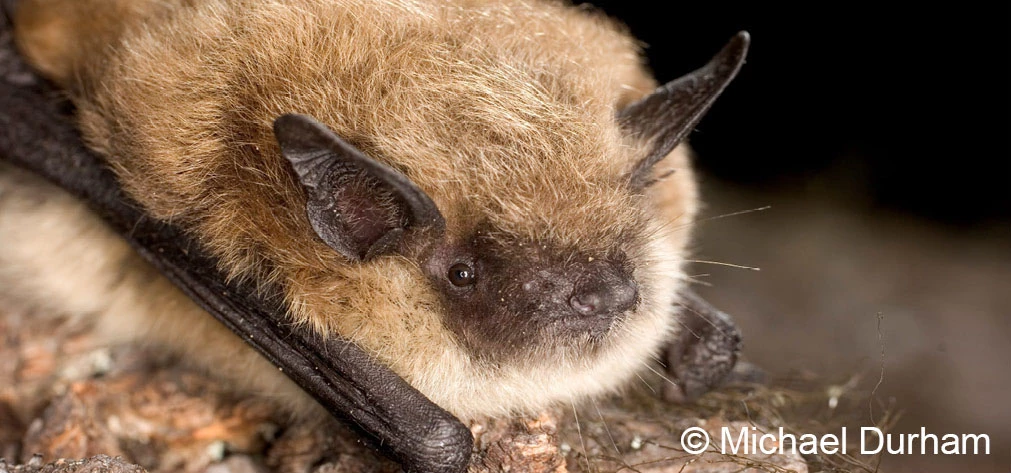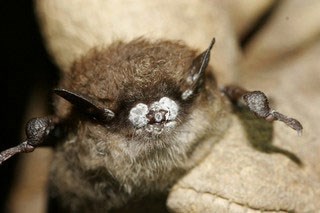Last updated: April 5, 2024
Article
Yuma Myotis Bat

copyright Michael Durham
Field Notes
General Description
The Yuma myotis bat, also known as Myotis yumanensis, is one of the smaller members of the vespertilionidae family. With a body length of only 1.5 to 1.9 inches, they weigh less than half an ounce! The physical appearance varies in color but ranges from dark to light brown fur. The underside of the bat is pale brown, while the ears are a dark glossy brown. The species was first recorded at Fort Yuma in California in 1864, just across the Colorado River from the town of Yuma, AZ, from which the scientific and common names are derived.
Habitat and Range
Although first spotted along the Arizona/California border, Yuma myotis has a wide range throughout western North America, from the Southwestern regions of Canada into Mexico. They occupy a diverse selection of habitats, including forests, riparian zones, deserts, and grasslands. This species is closely associated with rivers, streams, and lakes, as water provides optimal opportunities for foraging. Their preferred roosts are buildings and bridges, but they are also found in caves and abandoned mines in colonies of up to 10,000 bats. Bachelors will occasionally roost in abandoned swallow nests.Yuma myotis prefers warm temperatures, and hibernates during the winter, typically in cool caves and crevices. While less is known about their hibernation habits, we can assume they spend at least some of their time in torpor (classified by decreased activity, and a reduced body temperature and metabolic rate) and likely do not migrate long distances during winter months. In the Mojave region, we have documented Yuma myotis activity on warmer winter nights, specifically at Lake Mead National Recreation Area.

Dani Niziolek, Great Basin Institute / Klamath Network
Behavior
In true nocturnal fashion, these bats emerge at darkness to forage. By bouncing sound waves off objects (echolocation), they can locate and hunt insects. They use moderate length calls and are highly maneuverable flyers due to a wide wingspan in comparison to their small size, which is an average of 9.4 inches (23.9 cm).
Diet
Yuma myotis bats forage for insects predominantly over waterways. As optimal foragers, their diet varies depending on insect availability but typically includes moths, beetles, mosquitoes, midges, and flies.
Reproduction and Life History
Yuma myotis mating occurs during the Autumn months and is categorized into the polygynandrous mating system — a type of polygamy where each partner also mates with several other individuals. Females will give birth to only one pup in maternity colonies that can be up to several thousand bats. Reproduction occurs between Spring and Summer.
The average lifespan of this species in captivity is about eight years, but they can live over 10 years — one captured male was documented to be 14 years old. Because their lifespan is shorter than other mammals, and they have a slower reproduction rate, it is crucial for bat populations to stay healthy.
How does this pertain to the Mojave Desert Network?
Hint: They're local (and need our help).
Yuma myotis is one of Mojave Desert Network's very own resident bats! This species is one of several Myotis species that have been detected at the Network's parks, namely Joshua Tree National Park, Lake Mead National Recreation Area, and Mojave National Preserve.

NPS / von Linden
Conservation
Although Yuma myotis are currently categorized as "least concern" by the International Union for Conservation of Nature, they are facing looming threats due to White Nose Syndrome as well as habitat loss. Drying and warming conditions cause deterioration of habitat as bats depend on pools of water for drinking as well as foraging for insects that are abundant near water sources. White Nose Syndrome (WNS) is a fungal disease that has been sweeping the nation since 2006, killing 90-100% of some bat populations. The fungus, Pseudogymnoascus destructans (Pd) gives the muzzle a powdery white appearance and can damage wing tissues that are crucial in flight. WNS-affected bats are often woken up from hibernation more frequently or earlier than usual by the fungus infecting the skin,which sends them flying into still freezing temperatures that their bodies are not adapted to handle with little to no food available.
Yuma myotis bats were one of the first western species to be confirmed with White Nose Syndrome when some dead bats were found in Washington State in 2017. Because mortality by WNS has been observed within this species, some state legislatures have listed the species as one of "Special Concern". Members of the Myotis genus are especially susceptible to White Nose Syndrome, and the Yuma myotis is no exception – especially since they are cave dwelling which is where most bats pick up the disease.

NPS
What is the National Park Service doing to fight WNS?
We're doing lots of things! As a local example of research, Mojave Desert Inventory and Monitoring Network has a bat monitoring program that is busy tracking our parks' bat populations. We track species abundance and diversity across the parks, and once a year, we swab bats to test for presence of the fungus that causes WNS (think mini-COVID tests for bats!). Although WNS has not been detected in Nevada, California, or Arizona (states where we monitor bats), the fungus Pd is presumed to be present in the parks we monitor, based on low levels of the fungal DNA possibly being detected in 2021. Continued monitoring is important as in other areas it has taken one to several years after fungal detection for the disease WNS to be observed.
Additionally, NPS managers across the country may decide to close certain caves or areas to protect hibernating bats. There are also protocols in place at some parks to decontaminate shoes upon entering and exiting cave tours, to reduce the spread of the disease. Park interpretation and science communication staff also are hard at work educating visitors about WNS and the importance of protecting bat habitats.

NPS / Gretchen Baker
Why should I care?
While current evidence shows that WNS is not transmittable to humans, we still have many reasons to care. For one, declines in bats can indirectly affect our health as humans because they are a leading source of pest control. All those mosquitoes they eat at night correlate to less bug bites when you're camping! In the United States, bats provide an estimated value between 3.7 and 53 billion dollars each year in pest control services alone. Numerous bat species also play important roles as pollinators. Thank you bats!
References and Further Reading
Bat Conservation International – Myotis yumanensisNorth Amercan Bat Monitoring Program
National Park Service Bats Web Page
U.S. Geological Survey: Why Bats Are Important
White Nose Syndrome Response Team – Press Release
Western Bat Working Group
To learn more about bat monitoring in the Mojave Desert Network, visit our Bats Monitoring web page.
